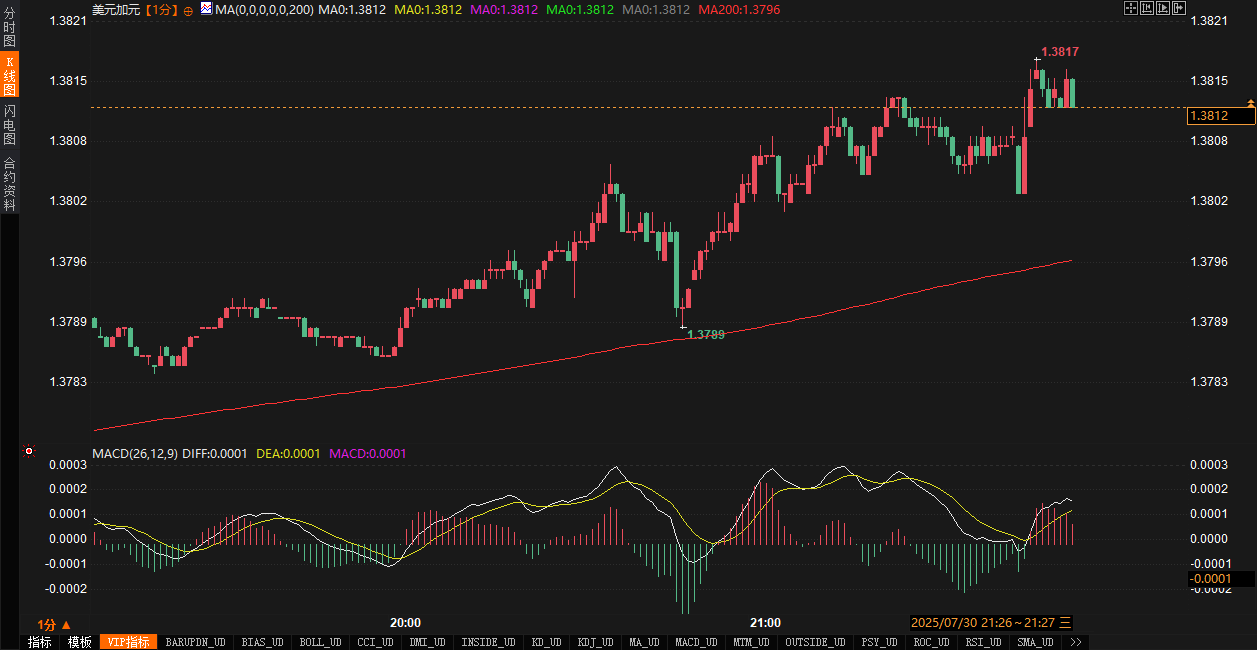The Bank of Canada suddenly released a "hawkish-dovish reverberation", and the US-Canada 1.38 defense line was tested again!
2025-07-30 22:00:55

Market Background and Resolution Overview
Entering 2025, the global economic environment continues to be weighed down by uncertainty surrounding US tariff policies. While Macklem noted that the global economic impact of US tariffs has been lower than expected, the impact on Canada's export sector has been significant. In particular, the tariff-induced decline in US demand in the second quarter of 2025 will cause the Canadian economy to contract by approximately 1.5%. Prior to the Bank of Canada's decision, the market generally expected the Bank of Canada to maintain interest rates unchanged to balance inflationary pressures with downside risks. The USD/CAD exchange rate fluctuated narrowly around the 1.38 mark before the decision, reflecting the market's wait-and-see attitude towards policy signals.
The Bank of Canada did not release its conventional economic forecasts in this decision, instead analyzing the current tariff scenario and two hypothetical scenarios of escalation and de-escalation. Macklem stated that while current inflation is close to the 2% target, underlying inflation has risen to 2.5% from 2% in the second half of last year, primarily driven by rising non-energy commodity prices. Canada's economy experienced strong growth in the first quarter due to the pullback of exports, but contracted in the second quarter due to a reversal of exports and the impact of tariffs. The unemployment rate rose to 6.9%, indicating labor market pressures, but the overall economy has been more resilient than expected.
Immediate market reactions and sentiment changes
Following the announcement of the decision, the USD/CAD exchange rate saw a short-term rally, rising from 1.3799 to 1.3809. While the gains were limited, they reflected the market's immediate interpretation of the Bank of Canada's cautious tone. Macklem emphasized that the central bank would prioritize short-term risks and be prepared to flexibly adjust policy based on new information. This statement was interpreted by the market as a reservation about the possibility of future rate cuts. While the decision met expectations, the USD/CAD rally suggests that traders are slightly more concerned about Canada's economic outlook, particularly the continued drag on exports from tariffs.

Historically, the USD/CAD exchange rate briefly surged to around 1.39 in early 2025 due to tariff uncertainty, but subsequently retreated to the 1.37-1.38 range amidst Canada's resilient economy and the appreciation of the Canadian dollar. The short-term rally following the decision failed to break through the recent high of 1.3850, indicating a relatively restrained market reaction. Prior to the decision, the market expected the Bank of Canada to signal a clearer rate cut, but Macklem's focus on rising inflation risks dispelled this expectation, putting short-term pressure on the Canadian dollar.
The reaction further reveals the divergence in market sentiment. Institutional investors are generally focused on Macklem's comments on inflation and tariffs. A prominent institutional analyst noted, "The Bank of Canada's concern about underlying inflation rising to 2.5% suggests limited room for rate cuts in the short term, and the USD/CAD exchange rate is likely to remain range-bound at 1.38-1.39." Another institutional trader stated, "Macklem's optimistic assessment of the impact of tariffs may be underestimated by the market, and downside risks to the Canadian dollar remain." In contrast, retail investor sentiment is more divided. Some believe that Canada's economic resilience has exceeded expectations, limiting the upside potential for the USD/CAD exchange rate, and prefer to short on rallies. However, others, concerned about further weakening of the Canadian dollar in the event of escalating tariffs, favor a bullish USD/CAD exchange rate of 1.40.
Compared to market sentiment before the decision, both institutional and retail investors generally expected interest rates to remain unchanged, but interpretations of the central bank's tone differed. Before the decision, some institutions predicted the central bank might signal a more dovish tone, hinting at a rate cut to address economic contraction. However, after the decision, Macklem's emphasis on upside inflation risks tempered market expectations of a rate cut, driving the USD/CAD pair higher in the short term. Retail investors, while prior to the decision, focused more on technical analysis, with heated discussions surrounding support and resistance at the 1.38 level, shifted their focus after the decision to the central bank's assessment of tariffs and inflation.
Expectations of the Federal Reserve's interest rate cut and its market impact
The indirect impact of this decision on expectations of a Fed rate cut deserves attention. The Bank of Canada explicitly stated that the global economy has been less impacted by US tariffs than expected, and while US economic growth has slowed, the labor market remains robust. This provides some support for the Fed to maintain its current policy rate. One institutional analyst commented, "The Bank of Canada's optimistic assessment of the resilience of the global economy may ease market expectations of aggressive Fed rate cuts. The USD/CAD exchange rate may rise in the short term due to the dollar's strength." However, downward pressure on the Canadian economy, particularly weak exports and investment, may limit the scope for further weakness in the Canadian dollar.
Market sentiment, which had been cautious before the decision, shifted to cautious optimism after the data release. The short-term rise in the USD/CAD exchange rate reflects market recognition of Canada's economic resilience, but tariff uncertainty and rising inflation risks have dampened bullish sentiment. Historically, the USD/CAD exchange rate fell to around 1.35 in the second half of 2024 due to rising expectations of a Fed rate cut, but tariff rhetoric in early 2025 boosted demand for the dollar. Following the decision, market expectations for a September Fed rate cut have slightly decreased, providing some support for the USD/CAD exchange rate.
Future Trend Outlook
Looking ahead, the USD/CAD exchange rate will remain volatile due to a combination of factors. In the short term, the 1.38-1.39 range remains a key area for observation. If tariff negotiations progress or US demand rebounds, USD/CAD could test support at 1.3750. Conversely, if tariff escalation materializes, the 1.40 level could be reached. The Bank of Canada's focus on upward inflation risks suggests a low likelihood of a near-term interest rate cut, limiting the Canadian dollar's potential for recovery.
In the medium term, Canada's economic resilience will continue to struggle against the uncertainty surrounding tariff policies. The regional surveys and new surveys cited by Macklem indicate that the Bank of Canada is closely monitoring the profound impact of tariffs on businesses and households. If underlying inflation remains above 2%, the Bank of Canada may further tighten its policy outlook, pushing USD/CAD back to the 1.42-1.45 range. However, if the global economic slowdown intensifies or the Federal Reserve cuts interest rates prematurely, USD/CAD could return to the 1.35-1.37 range.
The long-term trend depends on the global trade environment and Canada's ability to adjust. Under the current tariff scenario, Canada's economy is projected to gradually recover to 2% growth in 2026-2027, but escalating tariffs could lead to a longer period of low growth and high inflationary pressure. Institutional analysts generally believe that the USD/CAD exchange rate will fluctuate between 1.38 and 1.40 over the next six months, while retail investors prefer short-term speculative opportunities, focusing on the key levels of 1.3850 and 1.3750.
The Bank of Canada's interest rate decision on July 30th maintained policy continuity, but its cautious stance on inflation and tariffs prompted a market reassessment of the Canadian dollar's outlook. The short-term rise in the USD/CAD exchange rate reflects market concerns about downside risks to the economy, but the limited gains suggest a lack of bullish confidence. The diverging interpretations of institutional and retail investors highlight the differing market views on tariff policy and the inflation outlook. Moving forward, USD/CAD's trajectory will be shaped by the global trade environment, Canada's economic resilience, and Federal Reserve policy expectations. Traders should closely monitor the progress of tariff negotiations and inflation data to understand market dynamics.
- Risk Warning and Disclaimer
- The market involves risk, and trading may not be suitable for all investors. This article is for reference only and does not constitute personal investment advice, nor does it take into account certain users’ specific investment objectives, financial situation, or other needs. Any investment decisions made based on this information are at your own risk.





















